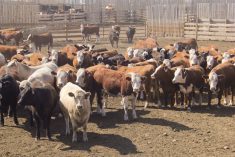The dynamics of flax movement in Western Canada are starting to see signs of change, according to industry officials.
Jonathon Driedger, an analyst with FarmLink Marketing Solutions in Winnipeg, said a small flax processor in Alberta has recently offered fairly attractive new-crop contracts for movement to China.
"In the past you’d see those kinds of contracts pop up in Saskatchewan and Manitoba and some of your traditional users of flax, but not necessarily in Alberta," he said.
Those contracts are starting to show up in Alberta because more and more flax is moving off the West Coast than before, due to increased demand from China In the past, the large majority of Canadian flax exports went through ports in Thunder Bay because they were destined for Europe and the U.S.
Read Also

U.S. livestock: Feeder cattle hit contract highs on tight supply
Chicago | Reuters – All Chicago Mercantile Exchange feeder cattle futures and most live cattle futures hit contract highs on…
Increased Chinese demand could have Alberta producers more interested in growing flax, because they will now have a freight advantage over producers in the eastern Prairies for crops moving through the West Coast.
Flax acres in Alberta could gradually increase over time because of this new freight advantage, but it’s not going to happen overnight.
"I don’t think I’d ever suggest we’re going to see a whole whack of flax acres in Alberta or that it will become the dominant province or anything like that," Driedger said. "But around the margins there’s a little interest picking up that probably wouldn’t have been the case in the past, based on where the flax used to go compared to where it’s going today."
That, however, will all depend on Chinese demand. The only way producers in the western half of the Prairies will keep the freight advantage for West Coast movement is if China continues to be a buyer of Canadian flax.
"Right now the chances are pretty good that that will continue to be the case as we move forward," Driedger said. "As with so many of these markets, China’s demand has grown, the amount they purchase has grown and they’ve become an increasingly important player."
But that doesn’t mean producers in Manitoba and Saskatchewan will be at a disadvantage. They will maintain freight advantages for the flax that moves out of Thunder Bay.
"A lot of our flax still goes to the U.S. and Manitoba and Saskatchewan would still have a competitive advantage from a freight perspective to feed the U.S. market," Driedger said. "And, as we’ve seen this year, there will still be windows when flax moves to Europe."
Eastern Prairie producers also have the advantage of local processing plants being nearby, he noted.
In the future, flax acres could become more prominent in the west, but not necessarily at the expense of eastern acres.
"If we do see acres grow a bit, then maybe some of that growth comes from the western half of the Prairies a little more so than in the past," he said.
Thus the dynamics of flax in Western Canada could start to change, but it will be more of an "evolution" then a dramatic trend change.
Canada grew 980,000 acres of flax in 2012, with 775,000 acres in Saskatchewan, 155,000 acres in Manitoba and 50,000 acres in Alberta, according to Statistics Canada data.
— Terryn Shiells writes for Commodity News Service Canada, a Winnipeg company specializing in grain and commodity market reporting.















